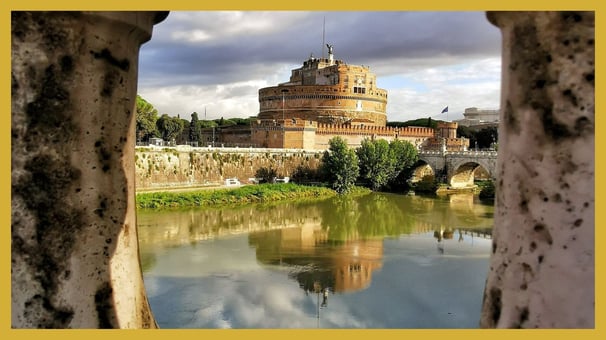Cultural and Historical Tours in Rome during the Jubilee
Contents
The Colosseum and the Imperial Forums
Castel Sant’Angelo and the Passetto di Borgo
The Pantheon: Temple and Church
Villa Borghese and Borghese Gallery
Religious and Historical Itineraries
Conclusion
During the 2025 Jubilee, Rome morphs into a focal point of spirituality and culture, offering pilgrims and visitors an opportunity to immerse themselves in the city’s ancient faith and history. Beyond its sacrosanct sites, Rome is enriched with an abundance of historical and cultural venues that are well worth exploring through specialized tours. This guide unveils the key cultural and historical tours that will enhance your jubilee experience, plunging you into the deep historical and artistic essence of the eternal city.


The Colosseum and the Imperial Forums
Undoubtedly one of Rome's most iconic landmarks is the Colosseum, emblematic of the Roman Empire’s grandeur with its architectural majesty and capability to host up to 50,000 spectators, making it an essential part of any cultural tour. This ancient amphitheater, which debuted in 80 AD, was the epicenter of gladiatorial spectacles and continues to bring imperial Rome’s history to life. The vastness of its structure and the sophistication of its design exemplify the Romans' power and engineering prowess, instrumental in erecting a monument meant to endure through the ages. Adjacent, the Imperial Forums were the nucleus of ancient Roman political and social life. As one walks among the remnants of temples, basilicas, and monuments, it becomes possible to relive the glory of ancient Rome while grasping the crucial role these spaces played in both public and private spheres.
For those eager to delve deeper into these historical sites, guided tours are available that include privileged access to the archaeological sites and neighboring monuments. The Colosseum Archaeological Park's official website provides options to purchase tickets and book tours in advance, ensuring a comprehensive and enriching experience filled with historical and cultural richness. Visitors can uncover curious tales and captivating stories, from emperors who spectated the games to gladiators who fought with valor and desperation
Castel Sant’Angelo and the Passetto di Borgo
Another historically compelling site is Castel Sant'Angelo, initially erected as a mausoleum for Emperor Hadrian and progressively transformed into a papal fortress across the centuries. This building encapsulates a layered history from the Roman era to the Renaissance, through periods of sieges and papal defenses. Beyond serving as a mausoleum, Castel Sant'Angelo has assumed various roles over the centuries—papal residence, prison, and defensive stronghold, thereby standing as one of Rome's most versatile historical sites. It is connected to the Vatican by the Passetto di Borgo, a secretive corridor used by popes as an escape route during times of peril. A notable instance involved Pope Clement VII, who in 1527 used it to evade the Sack of Rome by the Landsknechts—a pivotal act that preserved the pontiff’s life
Visiting Castel Sant'Angelo offers a chance to admire not only the fortifications and papal rooms, but also a breathtaking view of Rome from the upper terrace. From the castle’s summit, one can glimpse some of the city’s most captivating panoramas, including St. Peter's Basilica and the peaceful Tiber River gently flowing between its storied banks. Details on tours and guided visits are available on the official website of the Italian State Museums. Guided tours delve into the legends and secrets connected with the castle, immersing visitors in the history that has shaped this site over the centuries
The Pantheon: Temple and Church
An essential destination for any cultural tour in Rome is the Pantheon, one of ancient Rome’s best-preserved buildings, now a Catholic church called Santa Maria ad Martyres (St. Mary and the Martyrs). Constructed during the reign of Emperor Hadrian around 120 AD, the Pantheon is renowned for its monumental dome and the central oculus, which spectacularly allows natural light to illuminate its interior. Its engineering, boasting the largest dome ever crafted from unreinforced concrete, stands as one of antiquity's grandest feats. The Pantheon also serves as the final resting place for notable individuals, including the painter Raphael and various Italian royals
During Jubilee celebrations, a visit to the Pantheon offers a moment to marvel at the remarkable blend of classical architecture and Christian worship, evidenced by the altars and decorations added during the Christian era within the ancient temple. Stepping inside the Pantheon, one experiences a walk through history, noting how a pagan structure was adapted for Christian rites while retaining its original allure. The light streaming through the central oculus creates a dynamic ambiance that shifts with the time of day and seasons, making each visit uniquely memorable.
Villa Borghese and Borghese Gallery
For art enthusiasts, no cultural tour of Rome is complete without a visit to the Borghese Gallery, nestled within the stunning grounds of Villa Borghese. This museum showcases masterpieces by renowned artists such as Bernini, Caravaggio, Raphael and Titian, providing a journey through centuries of art history. The Gallery’s rooms boast lavish decorations that amplify the majesty of the artworks displayed, bringing them to life and narrating the tales of their creators and patrons.
Following the Gallery visit, guests can unwind in the gardens of Villa Borghese, one of Rome’s largest and most picturesque parks where art, nature, and history merge into a singular atmosphere. Key highlights include the Temple of Asclepius, a quaint Neoclassical structure set on an islet in the pond; the pond itself, inviting peaceful rowboat jaunts; the Pincio terrace with its sweeping city vistas that turn especially romantic at sunset; and the Cinema dei Piccoli, the world’s smallest cinema, which offers an intimate and enchanting viewing experience for viewers of all ages. The park also features a wealth of statues, fountains, and hidden gardens, ideal for a leisurely stroll. Reservations for the Borghese Gallery must be made in advance and can be completed on the official Borghese Gallery website
Religious and Historical Itineraries
Beyond the classic sites, Rome offers a wealth of religious itineraries that weave through its ancient narrative. One notable path is The Seven Churches Pilgrimage, a historic route established by Saint Philip Neri that traverses several of Rome's most significant basilicas. This pilgrimage provides a unique chance to blend faith with an exploration of the city’s artistic and cultural heritage. Each basilica on this journey tells its own story, adorned with artworks and relics that reflect the devotion of the faithful and underscore the spiritual importance of these sites through the ages.
Additionally, the Historic Jewish Quarter, often referred to as the Ghetto, is another locus of profound historical and cultural value. Visitors can explore the Synagogue of Rome and the Jewish Museum, which together chronicle the enduring presence of the Jewish community in the city. As one of the world's oldest Jewish quarters, the Ghetto offers heartfelt insights into the resilience and vibrant culture of its people. Meandering through its lanes, one encounters traditional shops and kosher eateries, as well as commemorative plaques that evoke the somber events of World War II.
Conclusion
During the 2025 Jubilee, Rome abounds with opportunities to uncover its vast cultural and historical legacy through guided tours and curated itineraries. From the majesty of the imperial monuments to the splendor of Renaissance and Baroque churches, venturing through the city invites pilgrims to immerse themselves not only in spirituality but also in the extraordinary chronicle of the Eternal City. Strategizing your exploration with the aid of guides and organized tours helps you fully appreciate the myriad treasures that Rome has to offer. Each corner of the city narrates a tale, and every monument stands as a chapter of human history, deserving recognition and celebration. Leveraging resources like expert guides and thematic tours ensures a comprehensive Jubilee experience, leaving you with lasting memories of a journey that transcends mere tourism to embody a profound spiritual and cultural pilgrimage.
Drop us a line
Follow us
Discover the Jubilee
Experience the Jubilee
Jubilee locations
Get ready for the Jubilee
Rome and the Jubilee
